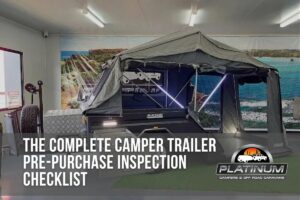
Dual Fold Camper Trailers: The Space-Saving Solution for Families
When it comes to family camping adventures across Australia’s diverse landscapes, space is everything. Large families often struggle to find camper trailers that provide adequate living space without compromising on towing capability or setup convenience. Dual fold camper trailers represent the perfect solution, combining innovative design with practical functionality to deliver maximum space efficiency for groups and families. Platinum Campers understands the unique challenges Australian families face when exploring the outback, coastal regions, and national parks. Our dual fold camper trailers, exemplified by the popular Chariot E1, offer unmatched space utilization through their ingenious double-fold system. These campers deliver the living space of a much larger trailer while maintaining compact towing dimensions and quick setup times. Overview This comprehensive guide explores everything you need to know about dual fold camper trailers and their space-saving advantages for family camping. You’ll discover how the innovative dual fold mechanism works, the specific benefits for large families, and why models like the Chariot E1 have become Australia’s preferred choice for group adventures. We’ll also cover essential considerations for selecting the right dual fold camper, financing options, and tips for maximizing your camping experience. Key Takeaways • Dual fold camper trailers provide maximum living space through innovative double-fold tent systems• The Chariot E1 offers sleeping for up to 8 people while maintaining compact towing dimensions• Quick setup times make dual fold campers ideal for frequent travelers and weekend adventurers• Enhanced storage solutions accommodate large family gear requirements• Off-road capability ensures access to remote camping destinations across Australia• Competitive pricing and flexible finance options make family camping more accessible• Comprehensive warranty and support network provide peace of mind for long-term adventures Understanding Dual Fold Camper Trailer Technology What Makes Dual Fold Different Dual fold camper trailers revolutionize space utilization through their innovative tent deployment system. Unlike traditional forward fold vs rear fold camper trailers, dual fold models feature two separate tent sections that unfold in opposite directions from a central chassis. This design creates a significantly larger living area while maintaining the compact towing profile essential for Australian road conditions. The dual fold mechanism typically includes a main sleeping area and a separate annexe or additional sleeping quarters. When deployed, these sections create distinct zones for different family activities—sleeping, dining, relaxation, and storage. This separation is particularly valuable for families with teenagers or multi-generational groups who need privacy and personal space during extended camping trips. The engineering behind dual fold systems focuses on structural integrity and weather resistance. Premium materials and robust frame construction ensure the expanded living area remains stable in various weather conditions, from coastal winds to inland storms. The tent fabric is typically made from heavy-duty canvas or ripstop polyester with waterproof coatings and reinforced stress points. The Chariot E1 Advantage Platinum Campers’ Chariot E1 exemplifies the best in dual fold technology, offering a sophisticated balance of space, durability, and convenience. The Chariot’s double-fold system creates an impressive living area that can comfortably accommodate up to 8 people, making it ideal for large families or groups of friends. The main tent area provides spacious sleeping quarters, while the secondary fold creates additional sleeping space or a dedicated social area. The Chariot E1’s setup process is remarkably straightforward despite its complex appearance. The dual fold mechanism uses heavy-duty hinges and support struts that deploy smoothly with minimal effort. Most families can complete the full setup in under 20 minutes, significantly faster than traditional large canvas tents or multiple smaller camping setups. Quality construction ensures the Chariot E1 withstands the demands of regular family use and harsh Australian conditions. The chassis features hot-dipped galvanized steel construction with independent suspension for superior off-road performance. Premium Aussie-made canvas provides excellent durability and weather protection, while reinforced guy ropes and tent poles ensure stability in challenging conditions. Space Maximization Benefits for Families Sleeping Capacity Solutions Large families consistently face the challenge of finding adequate sleeping arrangements when camping. Traditional camper trailers often limit families to 4-5 people, forcing parents to invest in additional tents or accommodation. Dual fold camper trailers eliminate this problem by providing genuine sleeping capacity for 6-8 people within a single, integrated system. The Chariot E1’s dual fold design creates distinct sleeping zones that enhance privacy and comfort. The main tent area typically accommodates parents or couples, while the secondary fold provides separate sleeping quarters for children or additional adults. This arrangement reduces disturbances during the night and allows different family members to follow their preferred sleep schedules. Bed configurations in dual fold trailers are designed for versatility and comfort. Quality innerspring mattresses ensure proper rest for all occupants, while the spacious tent areas accommodate various bed sizes and configurations. Many families appreciate the ability to set up separate children’s areas or create dedicated spaces for teenagers who value their independence during family trips. Storage and Organization Features Effective storage solutions are crucial for family camping success, and dual fold camper trailers excel in this area. The Chariot E1 incorporates extensive storage compartments throughout the chassis, including dedicated areas for clothing, food, camping equipment, and recreational gear. This organized approach eliminates the cluttered camping experience that often plagues large family trips. Internal storage within the tent areas includes overhead pockets, side compartments, and integrated shelving systems. These features keep personal items organized and easily accessible while maintaining the clean, spacious feel that makes camping enjoyable. External storage boxes provide secure space for valuable items like electronics, tools, and emergency supplies. The dual fold design also creates natural organization zones within the expanded living area. Families can designate specific areas for different activities—dining, relaxation, children’s play, and adult conversation. This separation helps maintain order and reduces conflicts over shared space, particularly important during extended camping trips or adverse weather conditions. Practical Advantages of Dual Fold Design Quick Setup and Pack-Down Time efficiency is a critical factor for busy families, and dual fold camper trailers deliver significant advantages in setup speed. The Chariot E1’s engineered deployment system allows even novice campers to establish a complete campsite








